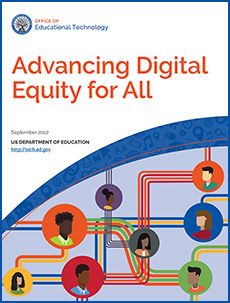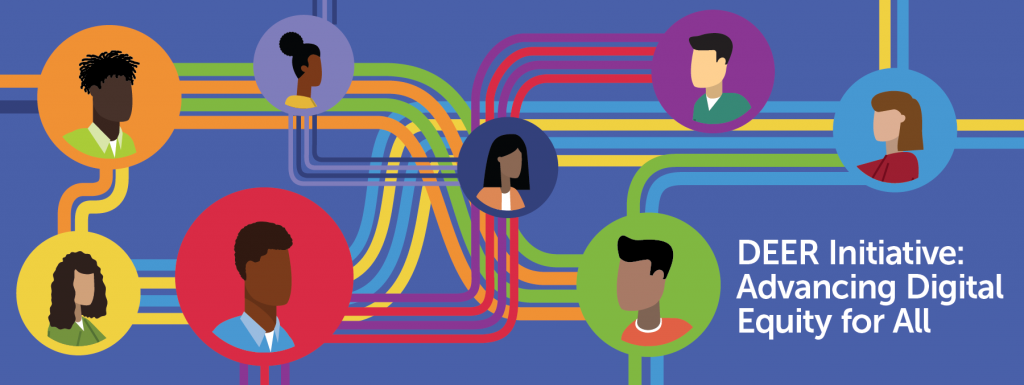Expanding Broadband Access and Technology-Enabled Learning
The Digital Equity Education Roundtables (DEER) initiative seeks to close the digital divide and enable all learners in PK-12, higher education, and adult education to unlock technology-enabled opportunities for learning and fully participate in a digital society. The U.S. Department of Education’s Office of Educational Technology (OET) will leverage its experience in setting the national vision for the effective use of technology for learning, strong relationships with educators and education ecosystems, and commitment to co-creating solutions with communities to drive the national dialogue on the adoption of reliable, high-speed internet and technology for learning and catalyze collective action to remove barriers for learners, families/caregivers, and communities. We envision a future in which every learner has the information, support, and skills to equitably access affordable, reliable, high-speed internet service, adequate internet-enabled devices, digital literacy training, quality technical support, and applications and online content designed to facilitate self-sufficiency, participation, and collaboration.
Featured Publication

Advancing Digital Equity for All
In spring 2022, the U.S. Department of Education’s Office of Educational Technology (OET) committed to advancing digital equity through the Digital Equity Education Roundtables (DEER) Initiative. Through DEER, OET hosted a series of national conversations with leaders from community-based organizations, as well as families and learners furthest from digital opportunities. The “Advancing Digital Equity for All” resource illuminates insights from these conversation to highlight the barriers faced by learner communities and promising solutions for increasing access to technology for learning.
“All of us can be a critical driver of the solutions”: Multi-Sector Leaders…
On September 28, 2022, the U.S. Department of Education Office of Educational Technology (OET) hosted the National Digital Equity Summit to launch Advancing Digital Equity…
Developing a Blueprint to Support Digital Equity for All: Community-based…
Digital equity is achieved when everyone has the necessary access to technology and literacy for using it to fully participate in society and the economy.
Three Components of Digital Equity
Digital equity is the condition in which individuals and communities have the information technology capacity that is needed for full participation in the society and economy of the United States. To ensure all learners have equitable access to reliable, high-speed internet service and technology tools for learning, we must consider:
- Availability: Is there sufficient infrastructure and coverage to deliver high-speed, reliable wired or wireless internet service?
- Affordability: Can learners and families/caregivers pay for the total cost of maintaining a high-speed, reliable internet service?
- Adoption: Do learners and families/caregivers have the information, support, and skills to obtain regular, adequate access to reliable, high-speed internet service and technology tools for learning?
A Historic Opportunity to Advance Digital Equity
The Bipartisan Infrastructure Law (BIL) addresses digital equity through a $65 billion investment, which aims to provide learners, families, and caregivers with the connectivity they need to engage in technology-enabled learning opportunities. As part of the BIL, the Digital Equity Act (P.L. 117-58 § 60301) calls on states to develop digital equity plans that identify barriers to digital inclusion and set measurable objectives to address them.
State Digital Equity Plans
To access BIL Digital Equity Act capacity building funds, states are required to identify barriers to digital inclusion and set measurable objectives to address them. Working together with members of the education community, state leaders must address how they will navigate the issue of broadband adoption in their state digital equity plans (as well as future iterations of these plans) to maximize the impact of their investments into broadband availability and affordability solutions.
Some foundational questions to consider:
- How will states partner with communities to co-create effective digital inclusion programs and resources and generate buy-in from the public?
- How will states strategically increase public awareness and understanding of new and existing digital inclusion programs and resources?
- How will states help learners, families, and caregivers navigate complexities in accessing digital inclusion programs and resources?
- How will states build necessary capacities, such as digital literacy, to directly empower stakeholders in fully taking advantage of the connectivity?

More Resources on Digital Equity and Broadband Programs
Need More Info?
- Contact ed.tech@ed.gov with questions.
- Please Include “OET DEER” in the Subject Line
- For a print-out and summary of the DEER Initiative, please review our DEER One-pager


